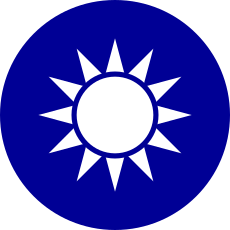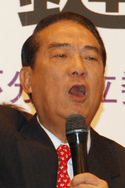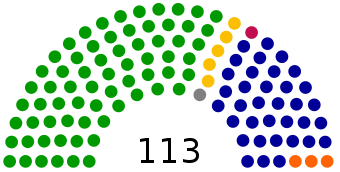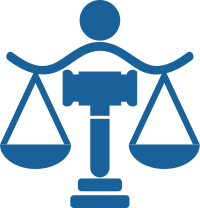Taiwan presidential election, 2012
| | |||||||||||||||||||||||||||||||||||||||
| |||||||||||||||||||||||||||||||||||||||
| |||||||||||||||||||||||||||||||||||||||
|
| |||||||||||||||||||||||||||||||||||||||
| Leaders in township-level units: Ma-Wu Ticket Tsai-Su Ticket | |||||||||||||||||||||||||||||||||||||||
| |||||||||||||||||||||||||||||||||||||||
| Taiwan presidential election, 2012 | |||
| Traditional Chinese | 第十三任中華民國總統副總統選舉 | ||
|---|---|---|---|
| |||
| This article is part of a series on the |
| Politics of the Republic of China |
|---|
 |
| Commonly known as Taiwan |
|
Leadership |
|
|
|
Other branches 
|
|
Related topics |
|
Taiwan portal |
The election for the 13th-term President and Vice-President of the Republic of China was held in Taiwan on 14 January 2012.[2] The election was held concurrently with legislative elections. It was the fifth direct election for the President of Taiwan. Prior to 1996, the President was elected by the ROC's National Assembly and not directly by the people.
Incumbent Ma Ying-jeou was re-elected as President with 51.6% of the vote. DPP challenger Tsai Ing-wen resigned her post as chairperson of the DPP following her election defeat.[3]
Background
The Kuomintang (KMT or Chinese Nationalist Party) ticket won a landslide victory in 2008 over the incumbent Democratic Progressive Party, with a 2.2 million vote margin on 58% of the valid votes.[4]
The administration of Ma Ying-jeou has been more friendly in policy towards the People's Republic of China and also signed the Economic Cooperation Framework Agreement (ECFA), a preferential trade agreement between the governments of China (PRC) and Taiwan (ROC).
The Democratic Progressive Party was hit hard with former president Chen Shui-bian's corruption revelations, but new chairwoman Tsai Ing-wen rebuilt the party, leading to a series of victories in legislative by-elections and local elections.
One big election topic appears to be the "1992 consensus", a term describing the declared outcome of a meeting in 1992 between the semi-official representatives of China (PRC) and Taiwan (ROC). The KMT agrees that this consensus should be the basis for negotiations with the PRC and supports it during the election,[5] while the DPP believes that no such consensus was reached[6] and that as a policy it is equivalent to the One-China principle, which the DPP opposes. Instead, the DPP has advocated that a "Taiwan consensus" be produced in a democratic way, by the legislature and a referendum of the people of Taiwan.[6][7]
Candidates
As determined by a random draw, the DPP's Tsai-Su ticket was listed first on Election Day ballots; the incumbent KMT's Ma-Wu ticket was listed second; and the People First Party (PFP)'s Soong-Lin ticket, third.[8]
Democratic Progressive Party
Incumbent chairperson Tsai Ing-wen was the DPP nominee. She was designated the party’s candidate in April 2011 following a primary by opinion polls. Candidates for the DPP primary were Tsai, former premier Su Tseng-chang and former chairman Hsu Hsin-liang. Former Vice President Annette Lu Hsiu-lien announced her intention to run but withdrew. On 9 September 2012 candidate Tsai chose DPP secretary-general Su Jia-chyuan as her running mate.[9]
Kuomintang

Incumbent President Ma Ying-jeou was standing for re-election.[10] There were no challengers within the party, so no primary was necessary.
Vice President Vincent Siew chose not to run for a second term, and on 19 June 2011 President Ma selected Premier Wu Den-yih as his running mate.[11]
Ma's campaign was run by King Pu-tsung, a former party Secretary-General.
People First Party
PFP chairman James Soong Chu-yu launched the party's first-ever Presidential bid on 20 September 2011. Soong had stated, however, that his candidacy is contingent on the success of a nationwide million signature drive. He has vowed to run and keep his candidacy active through the election if his campaign garners one million signatures throughout Taiwan.[12]
Soong chose National Taiwan University professor emeritus Lin Ruey-shiung, a career scientist and academic with no political experience, to be his running mate.
Soong contended that the Taiwanese people desire a third choice outside the two main parties (KMT and DPP), despite concerns that his decision may split the Pan-Blue coalition vote to hand victory to the Pan-Green candidate as may have happened in the 2000 Presidential election.[13][14]
Polls

After initially trailing, Ma started to pick up the lead, without Soong as a candidate, after September, 2011 in most opinion polls. However, Tsai benefited from the debates in the later stages.
Result
Voting took place between 8:00 and 16:00 local time at 14,806 polling stations.[15] After Ma's re-election,[16] he announced that his victory had vindicated his policies in regards to cross-strait relations.[17] Tsai conceded the election and resigned from her position as head of the DPP.[18] Turnout was reported to be over 74%.[19]
Ma Ying-jeou and Wu Den-yih were inaugurated as the President and Vice President of Taiwan respectively at the Presidential Office Building on 20 May 2012.[20]
| Party | Candidate | Votes | Percentage | |||
|---|---|---|---|---|---|---|
| President | Vice president | |||||
| |
Ma Ying-jeou | Wu Den-yih | 6,891,139 | 51.60% | | |
| |
Tsai Ing-Wen | Su Chia-chyuan | 6,093,578 | 45.63% | | |
| |
James Soong | Lin Ruey-shiung | 369,588 | 2.77% | | |
| Total | 13,354,305 | 100% | ||||
Reactions
 PRC – The State Council's Taiwan Affairs Office stated Ma's reelection proved the developments in cross-strait relations during his term is "the correct path that has won the support of the majority of the Taiwanese compatriots."[21]
PRC – The State Council's Taiwan Affairs Office stated Ma's reelection proved the developments in cross-strait relations during his term is "the correct path that has won the support of the majority of the Taiwanese compatriots."[21]-
 Hong Kong – Chief Executive candidate Henry Tang said the result reflects that Taiwanese people approve Ma's cross-strait policies, and expressed his wishes for peaceful and stable situation for economic development.[22]
Hong Kong – Chief Executive candidate Henry Tang said the result reflects that Taiwanese people approve Ma's cross-strait policies, and expressed his wishes for peaceful and stable situation for economic development.[22]  Singapore – Even before the confirmation of the result, the Ministry of Foreign Affairs issued a statement congratulating Ma[23] saying: "Singapore and Taiwan enjoy a close and friendly relationship which goes back many years [and that] they will continue to strengthen this relationship based on Singapore's "One China" policy." It added by wishing "all the parties success in working towards greater peace and prosperity, [sic] and securing the well-being of the future generations."
Singapore – Even before the confirmation of the result, the Ministry of Foreign Affairs issued a statement congratulating Ma[23] saying: "Singapore and Taiwan enjoy a close and friendly relationship which goes back many years [and that] they will continue to strengthen this relationship based on Singapore's "One China" policy." It added by wishing "all the parties success in working towards greater peace and prosperity, [sic] and securing the well-being of the future generations." United States – The White House issued a statement congratulating Ma and added it congratulates "the people of Taiwan on the successful conduct of their presidential and legislative elections;" also adding: "We hope the impressive efforts that both sides have undertaken in recent years to build cross-strait ties continue."[17]
United States – The White House issued a statement congratulating Ma and added it congratulates "the people of Taiwan on the successful conduct of their presidential and legislative elections;" also adding: "We hope the impressive efforts that both sides have undertaken in recent years to build cross-strait ties continue."[17]
See also
| Wikimedia Commons has media related to Taiwan presidential election, 2012. |
References
- 1 2 3 Central Election Commission, Taiwan. Last Retrieved 14 January 2012 at 9:18 pm Taipei time.
- ↑ Angella Tsai and Lilian Wu (21 April 2011). "Presidential, legislative poll set tentatively for Jan. 14". Central News Agency. Retrieved 27 April 2011.
- ↑ "Tsai steps down as DPP chair after election defeat" Focus Taiwan News Channel. 2012.01.14
- ↑ "USCI Symposium on 2008 Taiwan Presidential Election". USC US-China Institute. Retrieved 7 August 2011.
- ↑ "黃金十年". Kuomintang. Retrieved 9 January 2012.
- 1 2 "蔡:無92共識 推台灣共識". The Liberty Times. Retrieved 9 January 2012.
- ↑ "【十年政綱】一、國家安全戰略". Democratic Progressive Pary. Retrieved 9 January 2012.
- ↑ "Cna English News". Focustaiwan.tw. Retrieved 14 January 2012.
- ↑ Su Jia-chyuan picked as DPP vice-presidential candidate, 9 September 2011, retrieved 9 September 2011
- ↑ Mo Yan-chih (8 April 2011). "Ma sends KMT members to claim 2012 registration". Taipei Times. Retrieved 10 April 2011.
- ↑ Ma picks Wu as vice presidential candidate, 19 June 2011, retrieved 19 June 2010
- ↑ "James Soong announces Taiwan presidential bid". Asiaone.com. 21 September 2011. Retrieved 14 January 2012.
- ↑ http://lowyinterpreter.org/post/2011/10/04/Deja-vu-in-Taiwan.aspx
- ↑ "Asia Times Online :: China News, China Business News, Taiwan and Hong Kong News and Business". Atimes.com. 4 October 2011. Retrieved 14 January 2012.
- ↑ CEC finalizes two-in-one poll preparations Taiwan Today. 13 January 2012
- ↑ "2012年總統副總統及立法委員選舉 – 選情查詢系統". Cec.gov.tw. Retrieved 14 January 2012.
- 1 2 "Taiwan's China-Friendly President Re-Elected". Associated Press. 14 January 2012. Retrieved 14 January 2012.
- ↑ Wu, Sofia; Wang, Jamie; Lin, Kendra; Lee, James (14 January 2012). "Tsai steps down as DPP chair after election defeat (update)". Taipei. Central News Agency. Retrieved 14 January 2012.
- ↑ "New York Times article on election". Retrieved 14 January 2012.
- ↑ http://economictimes.indiatimes.com/slideshows/day-in-pics/may-20-2012/taiwan-president-ma-ying-jeou-attends-his-inauguration-ceremony/slideshow/13313605.cms
- ↑ Forsythe, Michael; Sun, Yu-Huay; Wong, Andrew (14 January 2012). "Ma Wins Second Term in Taiwan Election". Bloomberg News. Retrieved 14 January 2012.
- ↑ RTHK
- ↑
External links
- 2012 Presidential Election Press Kit, Government Information Office, Executive Yuan
Candidates
- Interviews
- "Interview With Taiwan President Ma Ying-jeou" New York Times. 5 January 2012
- "Interview With Tsai Ing-wen" New York Times. 5 January 2012
- Information





